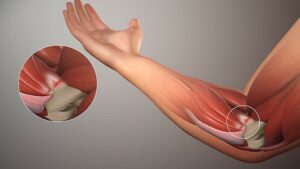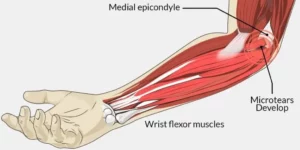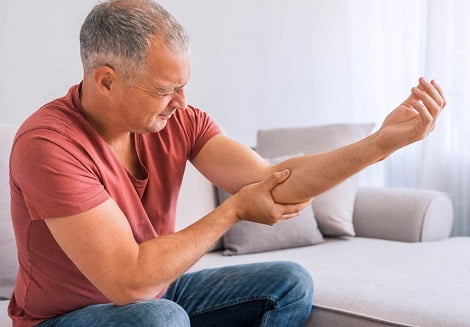Elbow pain, particularly in the inner elbow, can prove to be a daunting obstacle in our everyday life. It can significantly impact our ability to perform routine tasks, from writing to cooking to even carrying groceries. But what causes this discomfort? Is it a simple overuse of our arms or could there be an underlying condition? Welcome to our in-depth guide on inner elbow pain, where we’ll explore the potential causes, common symptoms, and treatment options to help you.
Contents
What Causes Inner Elbow Pain?
 Inner elbow pain can be caused by a variety of conditions, often related to overuse or strain of the muscles. Here are some of the most common causes:
Inner elbow pain can be caused by a variety of conditions, often related to overuse or strain of the muscles. Here are some of the most common causes:
1. Tennis Elbow (Lateral Epicondylitis)
Despite its name, this condition isn’t exclusive to tennis players. It’s caused by repetitive stress on the forearm muscles, resulting in inflammation and pain around the outer part of the elbow. However, it’s listed here because in some cases, it can also cause pain in the inner elbow.
2. Golfer’s Elbow (Medial Epicondylitis)
This is similar to tennis elbow but affects the inner side of the elbow. It occurs when the tendons that connect the forearm to the elbow become strained or torn, usually due to repetitive activities like golfing, lifting weights, or even using a computer.
This condition occurs when the ulnar nerve, which passes through the cubital tunnel (a passageway of muscle, ligament, and bone) on the inner side of the elbow, becomes compressed or irritated. It’s often caused by bending the elbow for extended periods, such as during sleep or while talking on the phone.
This is inflammation of the bursa, a small fluid-filled sac that acts as a cushion between the elbow bone and the skin. It can be caused by trauma, prolonged pressure on the elbow, infection, or certain medical conditions such as arthritis or gout.
5. Arthritis
Both osteoarthritis (wear-and-tear arthritis) and rheumatoid arthritis (an autoimmune disease) can cause pain in the inner elbow.
6. Elbow Fractures or Dislocations
These can cause severe, immediate pain in the inner elbow. They’re usually the result of an accident or injury.
Remember, if you’re experiencing persistent inner elbow pain, it’s important to seek medical attention to identify the cause and receive appropriate treatment.
Can Inner Elbow Pain Be Serious?
Inner elbow pain can range from mild and annoying to severe and debilitating. While it’s often a result of strain or overuse, which isn’t typically considered “serious” or life-threatening, it can sometimes indicate a more significant underlying condition.
Generally, this is serious if:
- Severe and sudden: Sudden, intense pain could be a sign of a severe injury, like a fracture or dislocation.
- Noticeable swelling or deformity: This could also indicate a severe injury, or it could be a sign of an infection or inflammatory condition.
- Not improving with rest and over-the-counter treatments: Pain that doesn’t get better after a few days of rest and non-prescription treatments, or that gets worse over time. Then, it may be a sign of a more serious issue, like a chronic condition or a severe injury that hasn’t healed properly.
- Other symptoms: If your elbow pain is accompanied by other symptoms like fever, unexplained weight loss, severe discomfort during rest or night, or a general feeling of being unwell. Then, it could be a symptom of a more serious condition.
- Restricts your movement: If the pain is limiting your range of motion or making it difficult to use your arm. That could be a sign of a serious condition that needs medical attention.
In any case, persistent or worsening elbow pain should be evaluated by a healthcare professional. They can provide a proper diagnosis and appropriate treatment options based on your specific circumstances.
How Do You Treat Inner Elbow Pain?
 The treatment for inner elbow pain largely depends on the cause of the discomfort. Here are some general strategies that may be suggested:
The treatment for inner elbow pain largely depends on the cause of the discomfort. Here are some general strategies that may be suggested:
Rest
Overusing or straining your arm can result in pain in the inner elbow. The first step in managing this discomfort is allowing your arm adequate rest. This helps minimize further damage and initiates the healing process. Avoid activities that aggravate the pain, and consider using your other arm more to compensate.
Physical Therapy
A physical therapist can guide you through exercises to fortify the muscles surrounding your elbow, improve flexibility, and encourage healing. This therapy may include gentle resistance exercises to enhance muscle strength and stretches to increase range of motion. In addition to these, they may use therapeutic modalities like ultrasound, electrical stimulation, or manual therapies (e.g., massage) to alleviate pain and inflammation.
Pain Relief Medications
Over-the-counter (OTC) nonsteroidal anti-inflammatory drugs (NSAIDs), such as ibuprofen or naproxen, can be used to diminish inflammation and offer pain relief. If the pain is severe, a doctor may prescribe stronger medications like opioids or muscle relaxants, albeit. But with caution due to potential side effects and the risk of dependency.
Ice and Heat Therapy
During the first 24-72 hours of acute pain or after any activity that aggravates the elbow, apply an ice pack to the area for 15-20 minutes at a time. This can help decrease swelling and numb the pain. After the inflammation has subsided, heat therapy in the form of a warm bath, heat pack, or hot towel can help relax and loosen tissues, thereby reducing pain and promoting healing.
Braces or Splints
A brace, splint, or elbow strap can provide additional support to the elbow, reduce strain on the muscles and tendons, and promote proper healing. These are especially useful for conditions like tennis elbow or golfer’s elbow. And can often be used during activities to prevent re-injury.
Surgery
In cases where conservative treatments are unsuccessful or the condition is severe—like in some cases of cubital tunnel syndrome, serious fractures, or severe arthritis—surgery may be necessary. Procedures can range from minimally invasive arthroscopy to more extensive reconstructive surgery, depending on the nature of the problem.
Lifestyle Modifications
Changes in daily activities can have a significant impact on managing and preventing inner elbow pain. This might include modifying your technique in sports or activities that strain the elbow, improving your workplace ergonomics if you use a computer or perform repetitive tasks, or incorporating regular low-impact exercise into your routine. And adopting a stretching and warm-up regimen before physical activities.
Remember, persistent or severe elbow pain warrants a medical consultation. These interventions should be pursued under the guidance of a healthcare professional.
What Is The Fastest Way To Relieve Elbow Pain?
 In addition to the R.I.C.E. method and NSAIDs, which are typically the first-line strategies for quick relief from elbow pain. Still, here are some helpful measures:
In addition to the R.I.C.E. method and NSAIDs, which are typically the first-line strategies for quick relief from elbow pain. Still, here are some helpful measures:
- Gentle Stretching
Gentle stretching exercises can help to relieve tension and improve flexibility in the affected area, reducing pain. It’s important to only do this to a point of slight discomfort and not to the point of pain.
- Over-the-counter Topical Creams
Topical creams, gels, and patches containing ingredients like menthol, capsaicin, or lidocaine can provide temporary relief from pain.
- Elbow Brace
Wearing an elbow brace or splint can help to support the elbow, reduce strain on the tendons or muscles, and provide relief from pain. These are especially helpful for conditions like tennis elbow or golfer’s elbow.
- Avoid Repetitive Motions
If possible, avoid repetitive motions and activities that may be causing or exacerbating your elbow pain.
- Ergonomic Adjustments
If your elbow pain is related to computer use or other work-related activities, making ergonomic adjustments can help. This may include adjusting your chair or desk, using a cushioned mouse pad, or taking regular breaks to stretch.
Remember, these strategies are typically for temporary relief and don’t address the underlying cause of your elbow pain. If your pain is severe, persistent, or affecting your ability to perform daily activities, it’s important to seek medical attention.
Conclusion
In conclusion, inner elbow pain, while common, should not be overlooked. Its causes can range from minor strains to serious conditions like arthritis or nerve compression. If you’re experiencing intense pain, it’s crucial to seek professional medical help. While home remedies and over-the-counter treatments can provide temporary relief, understanding and addressing the root cause is the key to long-term management and recovery.
Remember, being proactive in seeking care and following through with treatment not only alleviates your pain but also helps prevent potential future health complications. So, if you’re experiencing Elbow pain, physical therapy for elbow pain at PhysioMantra can help: Book an online physical therapy session.



